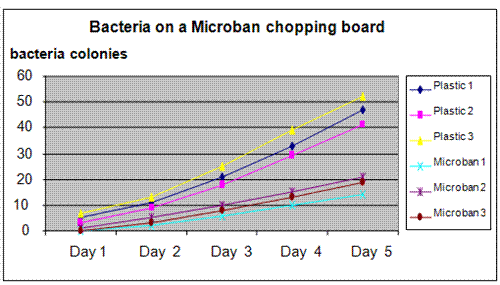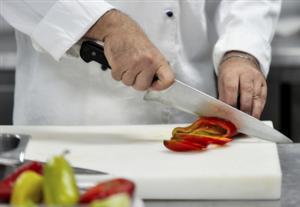| Complexity level: | 6 |
| Project cost ($): | 20 |
| Time required: | 1 day to prepare, 5 days for science fair project |
| Material availability: | Easily found |
| Safety concerns: | Pour some bleach into the Petri dish to kill all the bacteria before disposing of them in the trash. Ensure that you wear gloves at all times. Adult assistance required for handling knives. |
Hypothesis
Microban chopping boards have less bacteria growing on their surfaces.
Overview
Anti-microbial polymers
A different type of polymer with anti-microbial properties is now being used to prevent the growth of bacteria, fungi and mold, on the surface of consumer and industrial products. By adding anti-microbial additives into the raw materials during manufacturing, the end product will have a surface with anti-microbial properties.
anti-microbial polymers were developed by a group of engineers at the Microban Products Company in North Carolina. It is now being used to manufacture computer keyboards, chopping boards, counter tops, toys, medical equipment and many other products. Laboratory tests have shown that products using Microban polymers have a smaller number of microbes on their surfaces.
Unlike topically applied coatings, anti-microbial protection by Microban polymers do not wear off or wash away . The wear and tear on Microban polymer surface will only release more Microban molecules that will help protect the surface from further microbial growth.
Scientific Terms
Materials
The materials required for this science fair project :
- 6 agar Petri dishes
- 6 disinfected swabs
- 1 bottle of disinfected water
- 3 plastic chopping boards
- 3 Microban polymer chopping boards
- 1 knife
- 6 pieces of chicken
- Tap water
- A piece of soap
- 1 marker pen
Procedure
1. For this science fair project, the independent variable is the type of chopping board used – plastic and Microban polymer based. The dependent variable is the number of bacteria colonies growing in the petri dish. This is determined by observing and counting the number of bacteria “spots” (colonies). The constants (control variables) are the room temperature, the amount of sunlight and the ingredients in the petri dish agar.
2. The 6 petri dishes that have been prepared with agar are stored in a refrigerator. The petri dishes are brought to room temperature before the start of the science fair project, by taking them out of the refrigerator and allowing them to stabilize at room temperature. The petri dishes are labeled Plastic 1, Plastic 2, Plastic 3, Microban 1, Microban 2 and Microban 3.
3. Using a knife, scratch marks are made on the surfaces of the 3 plastic chopping boards and 3 Microban polymer chopping boards. The six pieces of chicken are then cleaned and cut up using the 6 chopping boards. The chopping boards are kept overnight after washing with soap and tap water.
4. The next day, a sterilized swab is first wet using sterilized water. The swabs are rubbed on the surface of the chopping boards and then rolled over the surface of the Petri dishes. The Petri dishes labeled “plastic” will be used for the plastic chopping board and the dish labeled as “Microban” for the Microban polymer chopping boards.
5. The cover is closed and the 5 Petri dishes are kept in a cool shaded place for the bacteria to grow.
6. The number of bacteria growth spots is counted everyday for the next 5 days and recorded in the table below.

Results
The results showed that the samples taken from the Microban polymer chopping board had a smaller number of bacteria colonies.
|
Chopping board |
Number of bacteria colonies |
||||
|
Day 1 |
Day 2 |
Day 3 |
Day 4 |
Day 5 |
|
|
Plastic 1 |
5 |
11 |
21 |
33 |
47 |
|
Plastic 2 |
3 |
9 |
18 |
29 |
41 |
|
Plastic 3 |
7 |
13 |
25 |
39 |
52 |
|
Microban 1 |
0 |
2 |
6 |
10 |
14 |
|
Microban 2 |
1 |
5 |
10 |
15 |
21 |
|
Microban 3 |
0 |
3 |
8 |
13 |
19 |
the graph below represents the results of our science experiment

Conclusion
The hypothesis that Microban chopping boards have less bacteria growing on their surfaces, is proven to be true.
Microban-based polymers make use of built-in anti-microbial properties to combat microbes on the surface. Since Microban molecules are built into the raw materials, the anti-microbial properties will not wear off. This provides the user with product-lifetime protection against bacterial growth
Also consider
The science fair project can be repeated with other Microban based products like a computer keyboard or mouse.
Try to repeat the science project to compare bacteria growth between Microban based products and anti-microbial sprays.
References
Microban germ warfare - http://www.mindfully.org/Plastic/Microban-Germ-Warfare.htm
Microban antimicrobial product protection - http://www.highel.com/Microban.html

